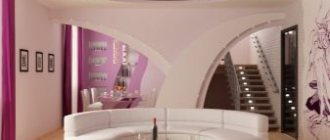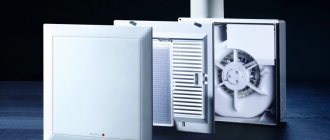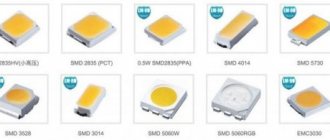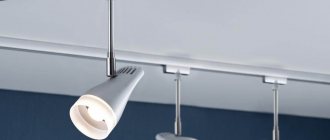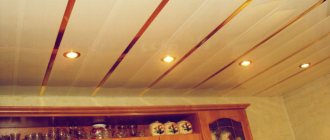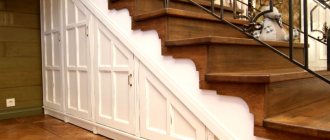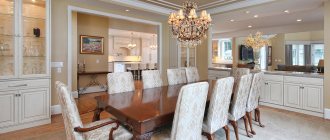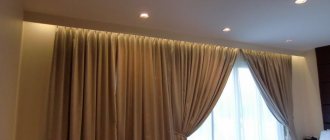No matter how original the interior is, everything can be ruined by the wrong light. It is not surprising that the issue of lighting occupies quite an important place when arranging premises for various purposes. Moreover, this is no less important for the bathroom than for other functional rooms.
We will tell you how to choose the right bathroom ceiling lamps from among the products offered for sale. We will advise you on what needs to be done for rational placement and error-free installation. Taking into account our recommendations, you can easily create a cozy and pleasant atmosphere in a hygienic room.
What to consider when choosing devices?
In the process of creating a design project, it is necessary to select the optimal model of the lamp, taking into account the characteristics of the room, the design and texture of the finishing materials.
For example, built-in models are not suitable for arranging a bathroom with a ceiling made of a monolithic concrete slab. In this case, it is better to use overhead fixtures or ceiling fixtures in the form of chandeliers.
In an effort to create a stylish interior and a comfortable environment, special attention must be paid to the choice of lighting equipment. In this case, it is necessary to take into account the design, characteristics, dimensions, lamp power, methods of mounting the electrical appliance and the need for additional structural elements.
When arranging a spacious room, designers advise focusing on traditional lighting solutions that will fit perfectly into the interior
If the bathroom is large, then a beautiful chandelier will look organic. But spot models, correctly and evenly distributed throughout the ceiling space, will allow you to create a stylish interior that takes into account current trends.
When choosing lamps, the following factors must be taken into account:
- room area and distance between lamps;
- zoning of the room, the need to highlight separate areas;
- instrument level;
- interior style direction;
- color scheme of walls, floors, furniture and plumbing;
- the presence of mirrors, tension structures, ceramic tiles and other surfaces that reflect light.
Before you begin installation work, you need to think through the layout of the light sources and the nuances of cable routing. Some models offered by manufacturers in the assortment require the creation of special conditions.
The quality of products directly affects their service life. Expensive branded models of built-in or surface-mounted lamps compare favorably with cheaper ones. They are of higher quality, wear-resistant, and therefore retain their aesthetic appearance for a long time.
In an effort to create a stylish and original interior in the bathroom, we must not forget about safety. Electrical devices intended for installation in rooms with high humidity must have a maximum degree of protection, which corresponds to the IP65 marking.
The bathroom is divided into zones with different humidity levels. The bright blue area is exposed to maximum splash water.
When arranging rooms with high humidity levels, certain rules must be followed.
The following recommendations will help you organize safe room lighting:
- You can only use moisture-resistant electrical appliances with a degree of protection of IP24;
- in areas of high humidity, install low-voltage devices up to 12 V;
- use lighting devices of protection class 2 near the bathtub or shower stall;
- it is desirable that all metal parts are made of stainless steel or have anti-corrosion properties;
- Light bulbs and other heated parts of electrical appliances must be equipped with protective covers or shades.
You should also remember about the features and properties of light rays. So, next to the washbasin it is better to use lamps with a softer yellow light. Otherwise, the mirror will reflect rather pale skin, which will prevent you from applying makeup correctly.
Our recommended article will familiarize you with the rules for choosing color temperature and the nomenclature designations of lighting devices, which allow you to select an LED light bulb in accordance with this important characteristic.
Proper lighting should be bright, soft and diffused. This will highlight the colors of the interior elements and finishing materials and create a cozy atmosphere.
For a bathroom with dimensions of 5x2 m, 2 lamps of 60 W are sufficient. You can use 2 lamps spaced on the sides, but in this case the mirror will require additional lighting. You can get acquainted with guidelines for selecting lighting devices for the bathroom in an informative article, the content of which is entirely devoted to this issue.
Laying electrical wiring on the ceiling
The correct location of light sources depends on the correct installation of electrical wiring. It is necessary to ensure that every corner of the room is equipped. Therefore, the placement of the cable is planned especially carefully. Rational placement of the cable will help save costs on its purchase.
It is recommended to mark the diagram on the ceiling with a marker. For protection, the electrical cable is placed in a corrugated pipe and then fixed to the ceiling. A copper cable with a cross-section of 1.5 mm2 monocore is purchased; the cable for sockets in the bathroom is laid with a cross-section of 2.5 mm2. The cable is run from the common distribution box of the apartment, which is located in the corridor.
It is recommended to connect lamps in groups of 2-3 pieces. This will allow you to turn on the lights in the room by zone, for example, above the shower stall, rather than in the entire bathroom. The fan is connected to one of the groups.
Cabling
On the ceiling, a grinder with a diamond-coated disk is used for scoring. The electric cable is placed in grooves, and a solution of cement and sand is covered on top. Starting and finishing putty levels the surface of the ceiling.
Suspended ceiling
Without gating, the cable is secured to the ceiling with staples. The cores are insulated before connecting the lamps.
Types of bathroom fixtures
When arranging any room, it is important to correctly select and install lighting fixtures, which for a combined bathroom or separate bathroom are divided into subgroups according to several criteria.
Location and level of moisture resistance
Light sources can be installed at various points in the room. Depending on this, they can be wall-mounted, ceiling-mounted, floor-mounted, built-in into a shower stall or into a mirror.
Ceiling variations are in particular demand among consumers. With their help you can achieve diffused and soft lighting in the bathroom.
There are ordinary and moisture-resistant lamps installed in the ceiling in the bathroom. The second option is intended for installation in rooms characterized by high humidity.
They are made of moisture-resistant materials, and their design does not allow splashes of water to get inside the device. The degree of protection is indicated on the device body, which allows you to accurately select a product for safe operation in difficult operating conditions.
Electrical equipment has an IP protection index. The first number is the degree of protection of the device from mechanical damage, and the second indicates its ability to prevent moisture penetration
Separation by placement method
Lamps can be open or recessed. These subgroups differ in the method of their placement - on the ceiling or on the wall of the room. Depending on this factor, they can be point-mounted and suspended or wall-mounted.
Spotlights mounted in the ceiling structure emit bright light. They can embody the designer’s idea - provide uniform general lighting or emphasize individual areas
Due to the fact that there is a high level of humidity in the bathroom, it is better to use lamps equipped with shades. If you use regular lamps, the contacts will quickly oxidize. This will make the device unsuitable for further use.
Optimal options for bathroom lighting: one lamp with a large bulb, several with a medium bulb or small spotlights
Features of built-in and overhead models
There is a wide range of lamps of different designs on the market. They can be attached to the base of the ceiling or above its level, regardless of the type - plasterboard, tension, slatted.
Depending on the mounting method, devices are divided into three types:
- invoices;
- mortise or built-in;
- semi-mortise.
Mortise ones differ in depth parameters. Therefore, when choosing, you should take into account the distance to which the ceiling in the room is lowered. The size of the space behind the ceiling structure is at least 40 mm. For individual lighting systems, it is necessary to lower the pendant systems by 85-100 mm, which is unacceptable for a bathroom with a low ceiling.
To achieve ideal bathroom lighting and create a comfortable environment in a small room, you need to choose the right electrical lighting fixtures
Built-in equipment has light directed downwards, so it does not cover the entire surface of the ceiling. And spot lighting illuminates the space locally, allowing you to create dim lighting in the bathroom.
This is the best option for rooms in which lamps and suspended ceilings will look ideal. They allow the apartment owner to create an original interior design by investing a minimum of money.
Built-in electrical appliances look stylish and are ideal for interior design in a minimalist style. Despite their simple design, they emit a sufficient amount of bright light
Overhead light sources have their own nuances when installed in a room with a suspended ceiling. It will be necessary to use hangers so that the fabric covering or film does not sag during operation.
Such models will look impressive and stylish in a modern interior. They leave bright highlights on glossy, textured, mirror and shiny materials.
The range of overhead lamps is very wide. Consumers can purchase compact globe light bulbs, luxurious chandeliers, and appliances with frosted or colored glass bases
The technical part of the semi-mortise device is installed in the inner part of the ceiling, and the lampshade is located outside.
For their installation, space is required behind the ceiling structure. In this case, the light is directed perpendicular to the plane and scattered throughout the room, which allows the use of more powerful light bulbs.
Semi-mortise models have the advantages of mortise and overhead models. They are relatively inexpensive, look aesthetically pleasing, create soft lighting and a cozy atmosphere
Lamps for slatted and suspended ceilings
LED spotlights in a slatted ceiling
A stretch ceiling is a film that is located approximately 3 - 5 cm below the main ceiling. Therefore, it is possible to install spotlights and their varieties in it - built-in, overhead and semi-mortise, as well as LED strips and chandeliers, spots and track systems. From the point of view of fastening reliability, these models do not cause problems. They usually try to select the power of halogen lamps no higher than 30 watts. LED and fluorescent are all suitable. When using incandescent lamps, you must ensure that the distance to the film is at least 30 cm.
When installing pendant lamps, the heating part is located far from the film, so it does not overheat and is not deformed.
There is a request for installing square spotlights to illuminate the bathtub: there should be a platform of a special size for them. This must be agreed upon when purchasing a ceiling and choosing lighting fixtures, otherwise the order will be very expensive.
Rotary and non-rotating devices
Directional light allows you to find the right solutions in lighting different areas. For this reason, rotary models are often used as targeted sources. They are distinguished by a relatively simple design - the body of the device is fixed in the inter-ceiling surface, and its outer part rotates.
The device can rotate in different directions and direct a beam of light to a specific area. It is used to highlight the bathtub, shower stall, sink and vanity.
This type of lamp is perfect for emphasizing individual bright elements of the interior - it will effectively display a unique vase, an attractive panel or an original floral arrangement.
Rotating models are characterized by the presence of a special movable design with a lamp that can adjust the light flux and direct
Fixed devices are distinguished by their stationary mounting and targeted lighting. When they are turned on, the light rays are directed in one direction, usually downwards.
In order to rationally distribute the light emanating from fixed models, they are installed in groups. The devices are placed in a line, in a circle or in some other way. Their number depends on the area of the room.
Spot models in which specific light bulbs are installed are compact. According to their design, they are divided into protruding from the ceiling surface and hidden in the ceiling suspension system.
Electrical appliances recessed into the bathroom ceiling are suitable for any interior design, but they provide less light. The light flow is directed clearly downwards and only a small area located under the device is illuminated.
Bathroom lamps can be used with different electric lamps. When choosing them, the design characteristics of the products are taken into account
Connecting point models
Twelve-volt light models are connected via a transformer. The connection is parallel. To calculate the number of sources, you need to find out the power of the transformer.
Conversely, purchasing a transformer begins with calculating the number of point sources and finding out their power. The transformer power is calculated with a reserve.
Types of lamps for lighting fixtures
Often, a simple and convenient incandescent lamp is chosen to organize lighting in the bathroom. It attracts with its low cost, but is inferior to halogen devices and LED models.
Its main disadvantages:
- short warranty period ranging from 1,000 to 1,500 hours;
- if the length of the plinth or size does not suit the design of the ceiling, the suspended structure must be lowered;
- It has no protection against power surges, so it quickly burns out.
If you regularly turn on the lights in the bathroom, instead of traditional lamps, it is better to give preference to a 5 times more economical option - energy-saving.
Energy-saving light bulbs are often used in bathrooms and washrooms equipped with pendant lights, most of which are equipped with sockets for regular light bulbs
Halogen lamps can be installed in ceilings that are low. In any case, the light flux will be uniform. They provide more light than classic ones, save energy and can be used 3 times longer.
These light bulbs also tend to burn out. To replace a damaged one with a working one, you need to remove the retaining ring located on the spring, remove the cone and install a new one.
A popular halogen lamp designed for installation in a cone-shaped spot fixture with a mirror reflector
It is not recommended to install lamps with capsule halogen light sources without protective glass.
LED lamps are distinguished by their aesthetic design and strict contour geometry. They are made in gold or silver shades, similar to the color spectrum of plumbing fixtures.
The advantages of LED lamps are aesthetics, versatility and compactness. The only negative is the high cost of the lamps
The main advantage of LED devices is the low level of electricity consumption. It is ten times smaller than the good old incandescent lamps.
In addition, a number of other advantages should be noted:
- the number of turns on and off does not reduce the service life of the product;
- maximum light output 120 lumens/watt;
- a wide spectrum is possible without the use of light filters;
- LED incandescence up to a maximum of 60 °C;
- safety in case of damage due to the absence of chemical compounds and glass fragments;
- long service life (up to 50,000 hours).
This type of lamp is characterized by the absence of a natural type of luminous flux. To slightly soften the monochrome of the harsh rays, you will have to use additional phosphors. To prevent the light from pulsating, you will need a balancing capacitor.
Bright LED lamps are placed in active areas - the bathroom or shower, next to the sink, in changing areas
Lamps in the bathroom interior
Shocking modern styles require original lighting. For example, for an interior decorated in the Art Deco style, bright lamps framed with expensive wood, genuine leather and stunning semi-precious stones are ideal.
For a bathroom in a laconic high-tech style, symmetrical and clear lighting in the washbasin area and even rows of silver spotlights are suitable. And classic presupposes naturalness, elegance and luxury - they install aesthetic sconces with shades on the walls and overhead glass or crystal products on the ceiling.
Placement of lighting fixtures in an art deco bathroom: chandelier on the ceiling, bright sconces near the mirror, lighting of the ceiling structure and along the steps of the podium
In a bathroom with a small area, the interior often gravitates towards minimalism, where you can diversify the lighting. For example, installing original lighting in the form of an LED strip that will illuminate certain areas. You can use lamps of different shades, combine electrical lighting devices - sconces, chandeliers, built-in spot models.
Location of light sources
When choosing the placement of lamps, it is necessary to make maximum use of the luminous flux emitted by them. In a room with a small area, it is advisable to install built-in light sources, placing them around the perimeter of the room.
Spotlights along the perimeter allow you to evenly illuminate the room, creating a modern and stylish interior
If you want to highlight individual zones, then you should consider placing decorative lighting in the designated places. As a rule, built-in spotlight products are intended for general lighting. For local lighting, decorative lighting from linear LED lamps or flexible LED strip is used.
As for the required number of lamps, here you will need rules for arranging residential premises. According to sanitary standards, bathroom illumination should be at least 50 lux.
According to the rules of the 1st quarter. m area can be illuminated with an incandescent lamp with a power of 25 or 30 W, fluorescent 5-7 W or LED 3-4 W
You can calculate how many lamps are needed to illuminate a small bathroom with parameters of 2x3 m. For this you will need:
- 2-3 incandescent lamps with a total power of 150-180 W;
- about 4 LEDs with an indicator of 18-24 W;
- or a dozen energy-saving ones at 30-40 W.
Knowing the power, you can determine the total number of lamps and choose a way to place them on the ceiling.
How to post?
Having decided on the ceiling and lamps, you should think about how to arrange them: around the perimeter, in a circle, arched, chaotic, oval, multi-tiered, cross-shaped. This choice also depends on the number of lamps, the emitted light spectrum and the size of the room.
In a small room, one lamp is enough, which is placed between the door and the mirror. For large rooms, you need to determine the required number of lamps.
Lamp power standards per 1 sq. m:
- LED – 2.7 W;
- energy saving - 4-6 W;
- halogen – 10-20 W;
- incandescent lamps – 25 W.
Due to the high level of humidity, there are some restrictions in installing lamps in the bathroom. Lighting fixtures can be placed vertically 2.25 m from the floor, no closer. With a standard ceiling of 2.5-2.7 m, 0.25-0.45 cm remains from the ceiling. Suspended and suspended ceilings, chandeliers, lampshades, spots should be placed above the bathtub and shower stall no lower.
Different types of fixtures will require different locations: a pendant or surface-mounted shade with a moisture-proof housing is attached to the base ceiling; suspended slatted and suspended ceilings are decorated with built-in spotlights. An LED strip in a silicone casing is attached to a PVC or chipboard panel (along the perimeter or a given smooth line).
It is important to know that one spot will illuminate approximately 2 square meters. m., and a spotlight - about 1.5 sq.
m. The more lamps, the less power of each of them. But at the same time, they should evenly illuminate all areas of the bathroom. To avoid glare, place the lamps perpendicular to surfaces with a mirror effect or at an angle.
Fixtures can vary in cost, as can ceilings, the main thing is to ensure safety. Only then will the beauty created be valuable.
You can learn how to choose the right lamps for the bathroom, their moisture-proof properties and mounting methods from the following video.
Related Posts
- Emergency lighting
- Proper lighting in the bathroom: design techniques + safety standards
- How to install light in a steam room?
- Staircase lighting in a private house: 35 photos
- Lighting for a private home
- What are track lamps, what are their advantages and features: how to choose and connect hanging lamps with or without a busbar?
- How to calculate how many lumens are needed per square meter in an apartment or other room
- LED lamps: warm light or cold, what’s the difference?
- Organizing proper lighting in a greenhouse: lamp placement diagrams and practical tips on how to install optimal lighting for greenhouses (95 photos)
- Comparative analysis of LED and incandescent lamps
- Fluorescent lamps: parameters, device, circuit, pros and cons compared to others
- LED tube lamps 9 and 18 W, length 600 and 1200 mm
- Spotlights in kitchen design: advantages and disadvantages, options for spotlights, how to choose the right one
- Illuminance unit
- DIY garage lighting
- DIY installation and connection of the lamp
- How to install sconces correctly: step-by-step instructions and installation tips
- Selecting and installing lighting for kitchen cabinets
- LED Color Temperature Chart
- How to properly connect a backlit spotlight?
- DIY LED phytolamp for seedlings
- Main types and parameters of outdoor lighting control cabinets
- How to change a light bulb in a suspended ceiling?
- Bathroom design in Khrushchev
- Installing lamps in a suspended ceiling: 6 ways
Read with this
- Emergency lighting
- Proper lighting in the bathroom: design techniques + safety standards
- How to install light in a steam room?
- Staircase lighting in a private house: 35 photos
- Lighting for a private home
- What are track lamps, what are their advantages and features: how to choose and connect hanging lamps with or without a busbar?
- How to calculate how many lumens are needed per square meter in an apartment or other room
- LED lamps: warm light or cold, what’s the difference?
- Organizing proper lighting in a greenhouse: lamp placement diagrams and practical tips on how to install optimal lighting for greenhouses (95 photos)
- Comparative analysis of LED and incandescent lamps
The nuances of installing lamps in the bathroom
It is important to take care of safety when arranging lighting in the bathroom. To do this, you need to check that the wiring in this room is grounded.
Another important point is to buy only lamp models with a sufficient level of protection. Do not forget that splashes from swimming can easily end up inside electrical appliances, which can lead to serious problems.
The complexity of installing lighting fixtures for suspended ceilings depends on the type of ceiling structure. If the bathroom has a ceiling made of PVC panels or plasterboard, then installing a light source will not be difficult. The lampshade must be inserted into the hole for the lamp, and then pressed with a spring.
Installation diagram of a popular spotlight for the bathroom. The device is installed in a ceiling structure made of PVC panels or plasterboard
If the bathroom has suspended ceilings, then lighting fixtures designed for suspended structures will be required. They are attached to guides or ceiling tiles.
The installation diagram of a compact spotlight on a suspended ceiling allows you to visually study the process of installing an electrical lighting fixture in the bathroom
Interesting ideas
The bathroom is illuminated by pendant lights around the perimeter of the ceiling, shelves and mirror.
Hanging and wall lamps to provide bright lighting in the bathroom.
Lamps with crystal pendants are the perfect combination for a classic bathroom
Organization of bathroom lighting
Light bulbs for bathroom lighting
Hanging lights in the bathroom
Each corner of the bathroom needs lighting of different intensities.
The material presented in the article will help you avoid mistakes in arranging bathroom lighting. It should be remembered that regardless of the choice of model and location, independent installation is only possible if you have the necessary knowledge.

